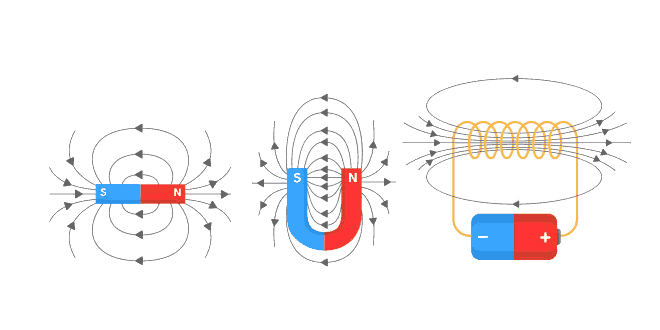Question: A current I passes through a circular loop C and a solenoid AB as shown below:

(1). What is the polarity of: (a) the face of the loop you are looking at? (b) the end B of the solenoid?
(2). What is the direction of the magnetic field at the centre of loop?
Answer:
- (a) The face of the loop will behave as a North Pole.
(b) End B will also behave as a North pole. - Straight and Parallel to the axis of the solenoid.
Question: Explain why a fuse should be joined with the live wire and not with the neutral wire in a domestic circuit.
Answer: In a domestic circuit, the phase wire is always at a much higher potential than neutral wire. Moreover, the neutral wire is connected to the earth at the substation. Thus, during short circuit they fuse will break the connection with the neutral wire and not the live wire.
Question: What is a solenoid? Draw the pattern of magnetic field lines of a solenoid through which a steady current flows.
Answer: A solenoid is a coil of many turns of insulated copper wire wound closely in the form of a cylinder. The magnetic field lines around a solenoid are as shown:
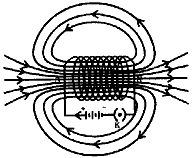
Question: Differentiate overloading and short-circuiting.
Answer: Overloading is connecting too many devices to a circuit.
Short-circuiting is the coming together of the live and the neutral wire.
Question: What are permanent magnet and electromagnet? Give two uses of each.
Answer: Permanent magnets have constant magnetic fields around it. When a soft iron is placed inside a solenoid and current is passed, it gets magnetised. The magnet so formed is called an electromagnet.
Uses: Permanent magnet – Electric generator, loudspeaker.
Electromagnet is used in (1) Cranes (2) Electric bell.
Question: Explain briefly different methods of producing induced emf.
Answer:
- By varying current is one coil emf can be induced in neighbouring coil.
- By moving a magnet towards a coil.
Question: What it the role fuse, used in series with any electrical appliance? Why should a fuse with defined rating not be replaced by one with a large rating?
Answer: Fuse is used for protecting appliances due to short-circuiting or overloading. The fuse is rated for a certain maximum current and blows off when a current more than the rated value flows through it. If a fuse is replaced by one with large ratings, the appliances may get damaged while the protecting fuse does not burn off.
Question: A magnetic compass shows a deflection when placed near a current carrying wire. How will the deflection of the compass get affected if the current in the wire is increased? Support your answer with a reason.
Answer: The deflection increases. The strength of magnetic field is directly proportional to the magnitude of curret passing through the straight conductor.
Question: AB is a currying conductor in the plane of the paper as shown in figure. What are the directions of magnetic fields produced by it at points P and Q? Given r1 > r2, where will the strength of the field be large?
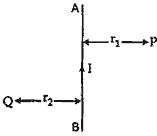
Answer: Into the place of paper at P and out of it at Q. The strength of the magnetic field is larger at the point located closer, i.e., Q.
Question: A magnetic compass needle is placed in the plane of paper near point A as shown in the figure. In which plane should a straight current carrying conductor be placed so that it passes through A and there is no change in the deflection of the compass? Under what condition is the deflection maximum and why?
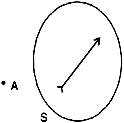
Answer: In the plane of the paper itself. The axis of the compass is vertical and the field due to the conductor is also vertical. It could result in a dip of compass needle which is not possible in this case (dips result only if axis of compass is horizontal). The deflection is maximum when the conductor through A is perpendicular to the plane of paper and the field due to it is maximum in the plane of the paper.
Question: No two magnetic field line can intersect each other. Explain.
Answer: If two field lines cross each other, at the two tangents at the point of intersection. This gives two directions of the magnetic field at the point of intersection. This is not possible.
Question: What is meant by the term magnetic field lines? List any two properties of magnetic field lines.
Answer: The lines drawn in a magnetic field along which a north pole would move.
Properties:
- Magnetic lines of force originate from North Pole and merge at South Pole.
- No two magnetic field lines intersect each other.
Question: Why does a current carrying conductor experience a force when it is placed in a magnetic field?
Answer: Because of interaction between the field due to current carrying conductor and the magnetic field in which the conductor is placed.
Question: A student while studying the force experiment by a current carrying conductor in magnetic field records the following observations:
(1). The force experienced by the conductor increase as the current is increased.
(2). The forced experienced by the conductor decreases as the strength of the magnetic field is increased.
Which of the two observation is correct and why?
Answer: Observation (1). is correct.
Because force experienced by a current carrying conductor in a magnetic field is proportional to the strength of the current.
Question: A student performs an experiment to study the magnetic effect of current around a current carrying straight conductor with the help of a magnetic compass. He reports that:
(1). the degree of deflection of the magnetic compass increases when the compass is moved away from the conductor.
(2). the degree when the current through the conductor is increased.
Which of the above observations of the student appears to be wrong and why?
Answer: The first observation is wrong. Because as the distance from the conductor increases, the strength of the magnetic field will decrease. So the degree of deflection of the compass should decrease instead of increasing.
Question: (1). What is the direction of magnetic field lines inside a bar magnet and outside of it? (2). What does the degree of closeness of the field lines represent?
Answer:
- The direction of magnetic field lines outside a bar magnet is from north seeking pole to south seeking pole while the magnet it is from south to north seeking pole.
- Degree of closeness of magnetic field line determines the strength of magnetic field. Stronger is the field at places where field lines are crowded.
Question: (1). What is electromagnetic induction?
(2). In what way can the magnitude of the induced current be increased?
Answer:
- The production of induced current in a coil placed in a region where the magnetic field changes with time.
- Increasing strength of magnetic field. Increasing the speed of movement of conductor.
Question: A magnetic compass shows a deflection when placed near a current carrying wire. How will the deflection of the compass get affected, if the current in the wire is increased? Support your answer with a reason.
Answer: The deflection increases. The strength of magnetic field is directly proportional to the magnitude of current passing through the straight conductor.
Question: How does the strength of the magnetic field at the centre of a circular coil of a wire depend on:
(1) radius of the coil
(2) number of turns in the coil.
Answer:
- As radius increases, field decreases.
- Field produced in directly proportional to the number of turn in the coil.
Question: Draw field line produced around a current carrying straight conductor passing through cardboard. How will the strength of the magnetic field change, when the point where magnetic field is to be determined, is moved away from the straight wire carrying constant? Justify your answer.
Answer: The diagram is as shown:
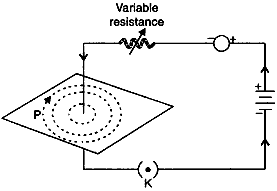
We will move a compass needle away from the straight wire. When it is moved away from the straight wire, the deflection of the needle decreases which implies the strength of the magnetic field decreases.
Question: Magnetic field lines are shown in the given diagram. A student make a statement that magnetic field at X is stronger at Y. Justify this statement. Also, redraw the diagram and mark the direction of magnetic field lines.
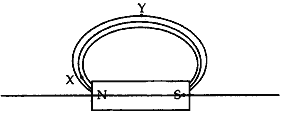
Answer: The relative strength of the magnetic field is shown by the degree of closeness of the field lines. The field lines are closer at X than at Y. Therefore, the field is stronger at X where the field lines are crowded. The diagram is as shown:
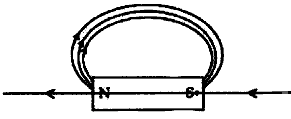
Question: Name and state the rule to determine the direction of a force experienced by a current carrying straight conductor placed in a magnetic field which is perpendicular to it. Name a device that uses current carrying conductor and magnetic field.
Answer: Fleming’s left hand rule: Stretch the thumb, forefinger and middle finger of the left hand such that they are mutually perpendicular. If the forefinger point in the direction of magnetic field, and the middle finger in the direction of current, then the thumb will point in the direction the force acting on the conductor. One such device is electric motor.
 Class Notes NCERT Solutions for CBSE Students
Class Notes NCERT Solutions for CBSE Students
